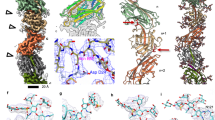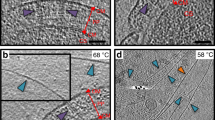Abstract
GRAM-negative bacteria are known to produce two types of surface organelles: flagella, which are required for motility and chemotaxis, and pili (fimbriae), which play a part in the interaction of bacteria with other bacteria and with eukaryotic host cells. Here we report a third class of E. coli surface organelles for which we propose the name curli. Curli are coiled surface structures composed of a single type of subunit, the curlin, which differs from all known pilin proteins and is synthesized in the absence of a cleavable signal peptide. Although the gene encoding this structural subunit, crl, is present and transcribed in most natural isolates of E. coli, only certain strains are able to assemble the subunit protein into curli. This assembly process occurs preferentially at growth temperatures below 37 °C. The ability of curli to mediate binding to fibronectin may be a virulence-associated property for wound colonization and for the colonization of fibronectin-coated surfaces.
This is a preview of subscription content, access via your institution
Access options
Subscribe to this journal
Receive 51 print issues and online access
$199.00 per year
only $3.90 per issue
Buy this article
- Purchase on Springer Link
- Instant access to full article PDF
Prices may be subject to local taxes which are calculated during checkout
Similar content being viewed by others
References
Overbecke, N., Bergmans, H., Mansfeld van F. & Lugtenberg, B. J. molec. Biol. 163, 513–532 (1983).
Nuesch, J. & Schumperli, D. Gene 32, 243–249 (1984).
Boyer, H. & Roulland-Dussoix, D. J. molec. Biol. 41, 459–472 (1969).
Matsudaira, P. J. biol. Chem. 262, 10,035–10,038 (1987).
Engström, A., Engström, P., Tao, Z.-J., Carlsson, A. & Bennich, H. EMBO J. 1, 2,065–2,070 (1984).
Lindberg, F., Lund, B. & Normark, S. Proc. natn. Acad. Sci. U.S.A. 83, 1,891–1,895 (1986).
Elleman, T. C. Microbial Rev. 52, 233–247 (1988).
Brenner, S. & Beckwith, J. R. J. molec. Biol. 13, 629–637 (1965).
Adler, H. I., Fischer, W. D., Cohen, A. & Hardigee, A. A. Proc. natn. Acad. Sci. U.S.A. 57, 321–326 (1967).
Clarke, L. & Carbon, J. Cell 9, 91–99 (1976).
fröman, G., Switalski, L. M., Faris, A., Wadström, T. & Höök, M. J. biol. Chem. 259, 14,899–14,905 (1984).
Thoretl, J. I. & Larson, S. M. Radioimmunoassay and Related Techniques (Mosby Co., St Louis, 1978).
Thompson, R. & Achtman, M. Molec. gen. Genet. 165, 295–304 (1978).
Achtman, M. et al. Infect. Immunity 39, 315–335 (1983).
Author information
Authors and Affiliations
Rights and permissions
About this article
Cite this article
Olsén, A., Jonsson, A. & Normark, S. Fibronectin binding mediated by a novel class of surface organelles on Escherichia coll. Nature 338, 652–655 (1989). https://doi.org/10.1038/338652a0
Received:
Accepted:
Issue Date:
DOI: https://doi.org/10.1038/338652a0
This article is cited by
-
Amyloids and prions in the light of evolution
Current Genetics (2023)
-
Staphylococcus aureus utilizes environmental RNA as a building material in specific polysaccharide-dependent biofilms
npj Biofilms and Microbiomes (2022)
-
Searching for putative virulence factors in the genomes of Shewanella indica and Shewanella algae
Archives of Microbiology (2021)
-
NMR insights into the pre-amyloid ensemble and secretion targeting of the curli subunit CsgA
Scientific Reports (2020)
-
Whole-genome analysis of the colonization-resistant bacterium Phytobacter sp. SCO41T isolated from Bacillus nematocida B16-fed adult Caenorhabditis elegans
Molecular Biology Reports (2019)
Comments
By submitting a comment you agree to abide by our Terms and Community Guidelines. If you find something abusive or that does not comply with our terms or guidelines please flag it as inappropriate.



